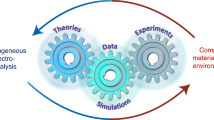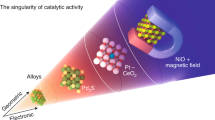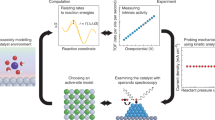Abstract
Kinetic models based on first principles are becoming common place in heterogeneous catalysis because of their ability to interpret experimental data, identify the rate-controlling step, guide experiments and predict novel materials. To overcome the tremendous computational cost of estimating parameters of complex networks on metal catalysts, approximate quantum mechanical calculations are employed that render models potentially inaccurate. Here, by introducing correlative global sensitivity analysis and uncertainty quantification, we show that neglecting correlations in the energies of species and reactions can lead to an incorrect identification of influential parameters and key reaction intermediates and reactions. We rationalize why models often underpredict reaction rates and show that, despite the uncertainty being large, the method can, in conjunction with experimental data, identify influential missing reaction pathways and provide insights into the catalyst active site and the kinetic reliability of a model. The method is demonstrated in ethanol steam reforming for hydrogen production for fuel cells.
This is a preview of subscription content, access via your institution
Access options
Subscribe to this journal
Receive 12 print issues and online access
$259.00 per year
only $21.58 per issue
Buy this article
- Purchase on Springer Link
- Instant access to full article PDF
Prices may be subject to local taxes which are calculated during checkout



Similar content being viewed by others
References
Bligaard, T. et al. Electronic-structure-based design of ordered alloys. MRS Bull. 31, 986–990 (2006).
Greeley, J., Jaramillo, T. F., Bonde, J., Chorkendorff, I. B. & Nørskov, J. K. Computational high-throughput screening of electrocatalytic materials for hydrogen evolution. Nature Mater. 5, 909–913 (2006).
Greeley, J. & Mavrikakis, M. Alloy catalysts designed from first principles. Nature Mater. 3, 810–815 (2004).
Greeley, J. & Norskov, J. Combinatorial density functional theory-based screening of surface alloys for the oxygen reduction reaction. J. Phys. Chem. C 113, 4932–4939 (2009).
Norskov, J., Bligaard, T., Rossmeisl, J. & Christensen, C. Towards the computational design of solid catalysts. Nature Chem. 1, 37–46 (2009).
Hansgen, D. A., Vlachos, D. G. & Chen, J. G. Using first principles to predict bimetallic catalysts for the ammonia decomposition reaction. Nature Chem. 2, 484–489 (2010).
Norskov, J. K., Abild-Pedersen, F., Studt, F. & Bligaard, T. Density functional theory in surface chemistry and catalysis. Proc. Natl Acad. Sci. USA 108, 937–943 (2011).
Wellendorff, J. et al. Density functionals for surface science: exchange-correlation model development with Bayesian error estimation. Phys. Rev. B 85 ( 2012).
Klimes, J. & Michaelides, A. Perspective: advances and challenges in treating van der Waals dispersion forces in density functional theory. J. Chem. Phys. 137, 120901 (2012).
Medford, A. J. et al. Assessing the reliability of calculated catalytic ammonia synthesis rates. Science 345, 197–200 (2014).
Salciccioli, M., Stamatakis, M., Caratzoulas, S. & Vlachos, D. G. A review of multiscale modeling of metal-catalyzed reactions: mechanism development for complexity and emergent behavior. Chem. Eng. Sci. 66, 4319–4355 (2011).
Campbell, C. T. Finding the rate-determining step in a mechanism: comparing DeDonder relations with the ‘degree of rate control’. J. Catal. 204, 520–524 (2001).
Stegelmann, C., Andreasen, A. & Campbell, C. T. Degree of rate control: how much the energies of intermediates and transition states control rates. J. Am. Chem. Soc. 131, 8077–8082 (2009).
Norskov, J., Bligaard, T. & Kleis, J. Rate control and reaction engineering. Science 324, 1655–1656 (2009).
Sutton, J. E., Panagiotopoulou, P., Verykios, X. E. & Vlachos, D. G. Combined DFT, microkinetic, and experimental study of ethanol steam reforming on Pt. J. Phys. Chem. C 117, 4691–4706 (2013).
Sutton, J. E. & Vlachos, D. G. Building large microkinetic models with first-principles' accuracy at reduced computational cost. Chem. Eng. Sci. 121, 190–199 (2015).
Gokhale, A. A., Kandoi, S., Greeley, J. P., Mavrikakis, M. & Dumesic, J. A. Molecular-level descriptions of surface chemistry in kinetic models using density functional theory. Chem. Eng. Sci. 59, 4679–4691 (2004).
Phatak, A. A. et al. Kinetics of the water–gas shift reaction on Pt catalysts supported on alumina and ceria. Catal. Today 123, 224–234 (2007).
Panagiotopoulou, P. & Kondarides, D. I. A comparative study of the water–gas shift activity of Pt catalysts supported on single (MOx) and composite (MOx/Al2O3, MOx/TiO2) metal oxide carriers. Catal. Today 127, 319–329 (2007).
Calle-Vallejo, F., Loffreda, D., KoperMarc, T. M. & Sautet, P. Introducing structural sensitivity into adsorption–energy scaling relations by means of coordination numbers. Nature Chem. 7, 403–410 (2015).
Nørskov, J. K. et al. Universality in heterogeneous catalysis. J. Catal. 209, 275–278 (2002).
Christensen, C. H. & Nørskov, J. K. A molecular view of heterogeneous catalysis. J. Chem. Phys. 128, 182503 (2008).
Kourtelesis, M., Panagiotopoulou, P. & Verykios, X. E. Influence of structural parameters on the reaction of low temperature ethanol steam reforming over Pt/Al2O3 catalysts. Catal. Today 258, 247–255 (2015).
Panagiotopoulou, P. & Verykios, X. E. Mechanistic aspects of the low temperature steam reforming of ethanol over supported Pt catalysts. Int. J. Hydrogen Energy 37, 16333–16345 (2012).
Sexton, B. A., Rendulic, K. D. & Hughes, A. E. Decomposition pathways of C1–C4 alcohols adsorbed on platinum (111). Surf. Sci. 121, 181–198 (1982).
Skoplyak, O., Barteau, M. A. & Chen, J. G. Ethanol and ethylene glycol on Ni/Pt(111) bimetallic surfaces: a DFT and HREELS study. Surf. Sci. 602, 3578–3587 (2008).
Alcala, R., Mavrikakis, M. & Dumesic, J. DFT studies for cleavage of C–C and C–O bonds in surface species derived from ethanol on Pt(111). J. Catal. 218, 178–190 (2003).
Alcala, R., Shabaker, J., Huber, G., Sanchez-Castillo, M. & Dumesic, J. Experimental and DFT studies of the conversion of ethanol and acetic acid on PtSn-based catalysts. J. Phys. Chem. B 109, 2074–2085 (2005).
Wang, H. & Liu, Z. Comprehensive mechanism and structure-sensitivity of ethanol oxidation on platinum: new transition-state searching method for resolving the complex reaction network. J. Am. Chem. Soc. 130, 10996–11004 (2008).
Wang, J.-H., Lee, C. S. & Lin, M. C. Mechanism of ethanol reforming: theoretical foundations. J. Phys. Chem. C 113, 6681–6688 (2009).
Guo, W. & Vlachos, D. G. On factors controlling activity of submonolayer bimetallic catalysts: nitrogen desorption. J. Chem. Phys. 140, 014703 (2014).
Stamatakis, M., Chen, Y. & Vlachos, D. G. First-principles-based kinetic Monte Carlo simulation of the structure sensitivity of the water–gas shift reaction on platinum surfaces. J. Phys. Chem. C 115, 24750–24762 (2011).
Dahl, S. et al. Role of steps in N2 activation on Ru(0001). Phys. Rev. Lett. 83, 1814–1817 (1999).
Bahn, S. R. & Jacobsen, K. W. An object-oriented scripting interface to a legacy electronic structure code. Comp. Sci. Eng. 4, 56–66 (2002).
Mortensen, J. J., Hansen, L. B. & Jacobsen, K. W. Real-space grid implementation of the projector augmented wave method. Phys. Rev. B 71, 035109 (2005).
Enkovaara, J. et al. Electronic structure calculations with GPAW: a real-space implementation of the projector augmented-wave method. J. Phys.-Cond. Matter 22, 253202 (2010).
Larsen, A. H., Vanin, M., Mortensen, J. J., Thygesen, K. S. & Jacobsen, K. W. Localized atomic basis set in the projector augmented wave method. Phys. Rev. B 80, 195112 (2009).
Perdew, J. P., Burke, K. & Ernzerhof, M. Generalized gradient approximation made simple. Phys. Rev. Lett. 77, 3865–3868 (1996).
Kucherenko, S., Rodriguez-Fernandez, M., Pantelides, C. & Shah, N. Monte Carlo evaluation of derivative-based global sensitivity measures. Reliab. Eng. Syst. Safety 94, 1135–1148 (2009).
Acknowledgements
The ethanol mechanism and the DFT calculations were supported by the Catalysis Center for Energy Innovation, an Energy Frontier Research Center funded by the US Department of Energy, Office of Science, Office of Basic Energy Sciences under award number DE-SC0001004. The uncertainty analysis formulation was supported by the US Department of Energy, Office of Basic Energy Sciences, under Contract No. DE-AC02-98CH10886 and Contract No. DE-SC0010723 and the sensitivity of model ensembles by grants R115-1342R1 and W911NF-15-2-0122 from the Defense Advanced Research Projects Agency. The DFT calculations were carried out at the TeraGrid provided by the Texas Advanced Computing Center of the University of Texas at Austin. The CGSA calculations were carried out on the clusters at the Center for Functional Nanomaterials at Brookhaven National Laboratory and the National Energy Research Scientific Computing Center.
Author information
Authors and Affiliations
Contributions
J.E.S. implemented the correlative SA, performed the calculations and analysed the results. W.G. performed the GPAW calculations. D.G.V. conceived the problem, M.A.K. formulated the mathematical foundations of the correlative SA and both supervised J.E.S. and W.G. All the authors contributed to writing the paper.
Corresponding author
Ethics declarations
Competing interests
The authors declare no competing financial interests.
Supplementary information
Supplementary information
Supplementary information (PDF 2989 kb)
Supplementary information
Supplementary Data 1 (XLSX 386 kb)
Rights and permissions
About this article
Cite this article
Sutton, J., Guo, W., Katsoulakis, M. et al. Effects of correlated parameters and uncertainty in electronic-structure-based chemical kinetic modelling. Nature Chem 8, 331–337 (2016). https://doi.org/10.1038/nchem.2454
Received:
Accepted:
Published:
Issue Date:
DOI: https://doi.org/10.1038/nchem.2454
This article is cited by
-
Active-site isolation in intermetallics enables precise identification of elementary reaction kinetics during olefin hydrogenation
Nature Catalysis (2023)
-
Enhancing the connection between computation and experiments in electrocatalysis
Nature Catalysis (2022)
-
Automated exploitation of the big configuration space of large adsorbates on transition metals reveals chemistry feasibility
Nature Communications (2022)
-
Predicting binding motifs of complex adsorbates using machine learning with a physics-inspired graph representation
Nature Computational Science (2022)
-
Autonomous Reaction Network Exploration in Homogeneous and Heterogeneous Catalysis
Topics in Catalysis (2022)



